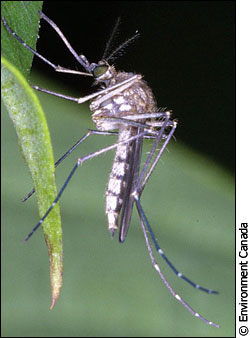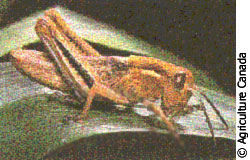| The
promise of mutant insects
By Carolyn Duncan
OTTAWA — Scientists
around the world are working to create the 'ideal' insects
to control infectious diseases and save crops.
 |
| A mosquito represents one
of many insect disease vectors. |
Imagine a world without insects. The annoying
hum of mosquitoes on a summer night gone, silenced by
a mysterious genetic mutation. What if the insects contributing
to tropical parasitic diseases and mass destruction
of crops were altered so they could no longer harm humans
or the economy?
Crops have been destroyed for centuries
by pests, and the solution to some insect problems may
be within reach. ‘Designer insects’ are
biotechnology’s newest contribution to both agriculture
and the possibility of parasitic disease control.
Dr. David O’Brochta, associate professor
of the Molecular Cell and Biology program at the University
of Maryland focussed directly on transposable elements,
or new artificial traits, that would attach to the DNA
of an insect and change its characteristics.
“To figure out how genes work,
isolate a gene, look at its structure, maybe change
and then put it back into an insect.”
| 'There
are lots of things we can do with it in the laboratory.
. . it's a very powerful molecular genetic tool
for people studying genes' |
“Technology is important
to significantly reduce the transfer of diseases,”
says Dr. Carl Lowenberger Associate Professor, Canadian
Research Chair in Parasitology and Vectors of Disease
at Simon Fraser University. He added that the concept
of disease eradication is still very far away, but researchers
have made progress.
The idea of genetically modified bugs
has been around since 1982. Researchers isolated transposable
elements, or genes that could be replicated in other
organisms in fruit flies (Drosophila) in the
1980s. According to Dr. Thomas Miller, Professor of
Entomology and Entomologist at the University of California
Riverside, these transposable elements were successfully
copied for the first time in 1995.
“After 1995 there was a floodgate,”
said Miller. “A number of insect transformists
were reported in the next period after that.”
Researchers hoped to make major advances
in disease control and agriculture. Genetic modification
of insects promised to slow the spread of tropical diseases
and to stop the destruction of crops.
‘Designer insects’ are created
by injecting insects with new DNA strands. A piece of
DNA that is coded for a new type of gene would be inserted
to an insect’s reproductive tissues during embryonic
development. For example, one could inject a DNA strand
coded for red eyes into the fertilized egg of a fruit
fly with white eyes. When the egg is laid, and the larva
grows, it would have red eyes rather than the white
eyes that its parent’s DNA would have dictated.
The bollworm's story
Miller’s research is specifically
with the pink bollworm, a pest that eats and burrows
in cotton plants, costing the U.S. cotton industry $30
million annually. It was an alien species, likely introduced
from cotton shipments of Australian or Indian origin,
and according to Miller, a worldwide problem.
“It’s a dry climate pest,”
he said. “You wouldn’t find it anywhere
east of the Mississippi River, and you won’t find
it in a wet climate.”
“Well we try to get bollworm eggs
within an hour after they’re laid,” explained
Miller. “We know when the females lay eggs, so
we reverse the life cycle in an incubation chamber,
and we convert their time to our convenience.”
Miller said that the DNA injected has
codes for enzymes that cut into the insect’s own
DNA, and therefore it continues to be replicated as
a part of its own genes. From there, research would
determine what can be done with different traits to
different types of insects.
The trait that he has introduced into
the bollworm’s DNA is a conditional lethal gene.
This ‘conditional lethal gene’ works against
a bollworm embryo’s natural ability to grow and
survive at cooler temperatures. The process has yet
to be perfected, but Miller hoped it would work to eliminate
the pink bollworm.
Another method he used to reduce the number
of pink bollworms in the wild was mass rearing and release
of sterile insects. The insects are exposed to radiation
just strong enough to render them sterile, then released.
They then contaminate the wild population and prevent
reproduction.
He said his team is doing the required
regulatory paperwork to get the transgenic pink bollworms
released in the wild.
“If you really want to eradicate
pink bollworm you have to do it on an area-wide basis
where everyone is doing the same thing,” said
Miller. “You have to maintain yourself pest-free
for at least five years to be absolutely certain you’ve
done a good job.”
Miller explained that it is a regulatory
process, and that many people are not willing to accept
the genetically engineered insects.
Malaria-resistant mosquitoes?
Lowenberger works with genetically modified
insects and transposable elements, too. His specialty
is the concept of manipulating the genes of insect vectors,
such as mosquitoes, to kill parasitic diseases.
“We’re looking to solve problems
like the West Nile virus, dengue and yellow fever,”
Lowenberger said. “Insect vectors are the causes
of many diseases.”
Methods of solving diseases are similar
to those that Miller used with the pink bollworms, but
Lowenberger said it is more uncertain. His work would
ideally end up manipulating the DNA of mosquitoes to
kill parasitic diseases such as malaria so they could
no longer transfer the disease to humans.
“Back in the 1960s we used DDT to
kill off all kinds of mosquitoes,” said Lowenberger.
“But that obviously didn’t work, and now
human health has even suffered from it.”
 |
| A DNA strand is the basis
of genetic engineering. |
“Malaria is an enormous killer,”
said O’Brochta. “One of the reasons for
developing this technology is that there are 400 million
clinical cases of malaria in the world in a year.”
The disease kills more people annually
than HIV/AIDS, and, according to O’Brochta, and
it has been around “forever.”
Insect vectors act as a catalyst to parasitic
diseases in many tropical countries. According to Lowenberger,
a parasite such as malaria has the ability to hide in
a mosquito without being detected by its immune system.
“In the gut of bugs is where changes
occur,” said Lowenberger. “The insect vectors
host bacteria and viruses into their immune system.”
When the parasite has matured, it would
transfer into a human host and make that person sick.
Lowenberger said it is a hit and miss process in manipulating
the DNA for an insect’s immune system.
“The main problem with creating
these types of insects,” he said, “is that
we cannot detect where the DNA sequence will enter the
insect.”
O’Brochta said the transposable
elements are something that he can attach any gene to,
and it will eventually be replicated into the DNA of
an insect. He found that the most effective time to
inject the insects in their reproductive organs, where
chances are greater that the new traits will be passed
on to the next generation of mosquitoes.
Detecting whether the immune system change
actually occurred was based on the presence of a different
indicator gene. For example, some traits are linked,
and when Lowenberger injected a strand of DNA with two
specific, different traits, he might see the phenotype,
or physical trait, and can therefore determine that
the genotype, or genetic trait, was also changed.
“Our goal is to make the insect
produce (as a genetic model) an antibody to neutralize
the parasite,” said Lowenberger. “This would
block the parasite from reproducing in cells, and reduce
its access to humans.”
A buggy future
All types of research with these transgenic
insects could ideally lead to constructive changes in
the world. The catch: the uncertainty of how genetically
engineered insects react in the wild. The issue raised
environmental ethical concerns. Studies that would determine
the effects of genetically engineered insects in an
ecosystem are difficult to control.
| 'Once you
let the genie out, you can’t get it back.
It’s an ethical situation. . . you can’t
easily measure the impact on human health.' |
Lowenberger pointed out that especially
in developing countries where parasitic diseases are
most prevalent that the people would not necessarily
have the education required to understand a test study
of the release of genetically engineered insects.
“Once you let the genie out, you
can’t get it back,” he said. “It’s
an ethical situation, a village of a developing country
or a problem area, you can’t easily measure the
impact on human health.”
Lowenberger expressed other concerns
about the fitness of transgenic insects. “Genetically
engineering insects in the lab, they have fitness tests,
but can they be used practically? Then if you can, how
do you drive the ‘new’ insects into the
wild population?”
His questions are part of what he referred
to as part of the “pie in the sky” situation.
Lowenberger said the concept of using these insects
could work, but there are so many things to be considered
before releasing them.
O’Brochta referred to the genetic
engineering of mosquitoes to reduce the prevalence of
malaria as “fairly speculative, and pretty ambitious,
and not really that close to being accomplished, but
we’re sort of getting all the tools together…”
Would these insects manage to mutate in
a natural way in order to survive? Studies have not
yet determined if genetically modified insects would
overcome their differences. It would take an extended
period of time, and according to Lowenberger, hundreds
of different effects of all kinds of transgenic insects
are unknown.
“We’ll be altering the insect’s
ability to serve as a host to a pathogen, or cause of
a disease, and it might become a poor host for that
one pathogen,” said O’Brochta. “One
risk is that we might make it a better host for another
new pathogen.”
O’Brochta added that he tried to
address as many concerns as possible in the laboratory,
where he can immediately fix any problems.
“How do we get that characteristic
into the entire population of mosquitoes?” O’Brochta
wondered. “It’s not going to be just a matter
of opening a window and letting them go…”
Regulatory processes for the United States
and Canada would be very similar regarding the release
of genetically engineered insects. Miller said it involved
a lot of paperwork and background research.
Miller was optimistic about the future
of pink bollworms in agriculture. Genetically engineered
insects would certainly be effective. He said that the
only problem he encountered was the fitness of the insects,
and that his team was working on making them survive
in the wild.
 |
| Grasshoppers are a pest to
crops. Are they next up for genetic modification? |
“If you release a genetically modified
pink bollworm to the environment, there’s nothing
in the environment to mate with for one thing, for another
thing, it’s in the soil for the most part,”
said Miller. “It’s not something that intrudes
in the environment at all because it’s a brand
new pest. You can follow the infestation from the early
1900s,”
Environmental impacts would still be difficult
to gage. Lowenberger pointed out that humans have never
been able to fully eradicate pests. Biological evolution
could compensate for the changes made to insects.
“We would look to replace the wild
population with one that would not be able to transmit
the parasite – a new mosquito,” said Lowenberger.
‘Designer bugs’ might not
have made any major impacts on disease eradication or
agricultural practises yet, but it is still early in
the research phase. O’Brochta, Lowenberger and
Miller all pointed out the massive potential for their
research. They would not silence today’s insects,
but the goal is to make them less dangerous and destructive
for people.
“We can make the bugs,” said
O’Brochta. “In the near future we’ll
make them do exactly what we want them to do.”
|